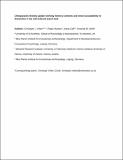Chimpanzees flexibly update working memory contents and show susceptibility to distraction in the self-ordered search task
Abstract
Working memory (WM) is a core executive function that allows individuals to hold, process, and manipulate information. WM capacity has been repeatedly nominated as a key factor in human cognitive evolution; nevertheless, little is known about the WM abilities of our closest primate relatives. In this study, we examined signatures of WM ability in chimpanzees (Pan troglodytes). Standard WM tasks for humans (Homo sapiens) often require participants to continuously update their WM. In Experiment 1, we implemented this updating requirement in a foraging situation:zoo-housed chimpanzees (N=13) searched for food in an array of containers. To avoid redundant searches, they needed to continuously update which containers they had already visited (similar to WM paradigms for human children) with 15-sretention intervals in between each choice. We examined chimpanzees’ WM capacity and to what extent they used spatial cues and object features to memorize their previous choices. In Experiment 2, we investigated how susceptible their WM was to attentional interference, an important signature, setting WM in humans apart from long-term memory. We found large individual differences with some individuals remembering at least their last four choices. Chimpanzees used a combination of spatial cues and object features to remember which boxes they had chosen already. Moreover, their performance decreased specifically when competing memory information was introduced. Finally, we found that individual differences in task performance were highly reliable over time. Together, these findings show remarkable similarities between human and chimpanzee WM abilities despite evolutionary and life history differences.
Citation
Voelter , C J , Mundry , R , Call , J & Seed , A M 2019 , ' Chimpanzees flexibly update working memory contents and show susceptibility to distraction in the self-ordered search task ' , Proceedings of the Royal Society B: Biological Sciences , vol. 286 , no. 1907 . https://doi.org/10.1098/rspb.2019.0715
Publication
Proceedings of the Royal Society B: Biological Sciences
Status
Peer reviewed
ISSN
0962-8452Type
Journal article
Description
This project has received funding from the European Research Council under the European Union’s Horizon 2020 research and innovation program (grant agreement No. 639072).Collections
Items in the St Andrews Research Repository are protected by copyright, with all rights reserved, unless otherwise indicated.

